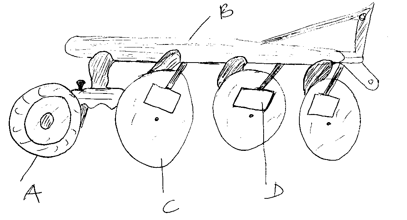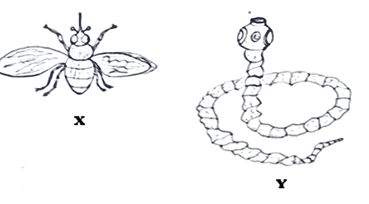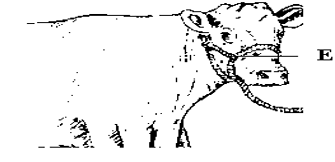QUESTIONS
SECTION A (30MARKS)
Answer all the questions in this section.
- State two reasons of using farm tools and equipment in the farm. (2mks)
- State three reasons that would make a farmer prefer to keep indigenous cattle breeds instead of exotic cattle breeds. (1½mks)
- State three characteristics of Bactrian (Camelus bacterianus) type of camel. (1½mks)
- Name four factors that influence the pulse rate in farm animals. (2mks)
- State three symptoms of endoparasites attack in livestock. (1½mks)
- State four factors that determine the amount of food given to an animal. (2mks)
- Name three advantages of using a machakos dip as compared to a plunge dip (1½mks)
- State four factors considered when selecting construction materials. (2mks)
- Name three methods a farmer can use when selecting livestock for breeding in the farm. (1½mks)
- State three signs of heat in a doe. (1½mks)
- State four reasons for carrying out identification in livestock. (2mks)
- State two diseases that commonly affect bees in bee farming. (2mks)
- State four methods a farmer can use when preserving fish after harvesting. (2mks)
- State four factors that determine the choice of poultry rearing system that a farmer chooses to use. (2mks)
- State one advantage of using mobile calf pen in calf rearing. (1mk)
- State two disadvantages of a two stroke engine. (1mk)
- State two factors that could cause sudden stopping of a tractor engine. (1mk)
- State four disadvantages of animal drawn implements over tractor drawn implements. (2mks)
SECTION B (20MARKS)
Answer all questions in this section.
- The diagram below shows a tractor drawn implement. Study it and answer the questions that follow.

- Name the parts A, B, C and D. (4mks)
- State two advantages of using the above implement over mould- board plough. (2mks)
- State the function of the parts labeled. (2mks)
- A
- D
- The diagram below shows livestock parasites. Study the diagrams and answer the questions that follow.

- Identify the parasites X and Y above. (2mks)
- State two effects that are caused by the parasite labeled X on the animal’s body. (2mks)
- Name one disease transmitted by parasite labeled X above. (1mk)
- State three measures taken to control the parasite labeled Y above. (3mks)
- Study the diagram below and answer the questions that follow.

- Identify the livestock equipment marked E above. (1mk)
- State three reasons that make branding be discouraged as a method of livestock identification.(3mk)
- What is caponisation as used in poultry production. (1mk)
SECTION C (40 MARKS)
Answer any two questions.
-
- State and explain five factors that predispose livestock to diseases. (10mks)
- State and explain five factors a farmer will consider when siting beehives in the farm. (10mks)
-
- Briefly state and explain five equipment a farmer will need when milking and state their uses. (10mks)
- Explain five factors to consider when selecting a breeding stock. (10mks)
-
- State and explain four materials collected by bees. (8mks)
- State and explain the use of four equipments a honey harvester would require to have when harvesting honey. (8mks)
- List four main reasons that make fish farming popular. (4mks)
MARKING SCHEME
- Reasons of using farm tools and equipment in the farm. 2x1=2mks
- to increase efficiency on the farm
- to enhance production
- to enhance safety on the farm
- Reasons that a farmer opts to rear indigenous cattle breeds over the exotic breeds. 3x ½ =1 ½ mks
- they can withstand high temperatures
- they are capable of walking for long distances in search of pasture and water.
- they are more resistant to most of tropical diseases and pest attack
- they can survive on poor quality pastures
- Characteristics of bacterian type of camel. 3x ½ =3mks
- it has two humps
- it is heavy and has short legs
- it lives in cold region hence has thick and long coat
- Factors that influence the pulse rate of an animal. 4x ½ =2mks
- the degree of excitement
- the age of the animal
- the sex of the animal
- physiological status of the animal e.g. pregnancy
- Signs of attack by endoparasite a farmer can observe. 3x ½ =1 ½ mks
- loss of weight and emaciation
- pot bellied
- the animal will suffer indigestion
- anaemic condition due to sucking of blood
- swollen and painful abdomen
- dullness and the animal appearing depressed
- Factors that determine the amount of food given to an animal. 4x ½ =2mks
- body size or weight of the animal
- environmental conditions within which the animal
- physiological condition of the animal
- level of production
- purpose for which the animal is kept
- Reasons why a farmer may use machakos dip instead of a plunge dip to control ticks. 3x ½ = 1 ½ mks
- scarcity of water
- shortage of capital
- small number of herds
- Factors considered when selecting construction materials. 4x ½ = 2mks
- availability of materials
- cost of materials
- suitability of materials
- durability of materials
- strength of the material
- workability of the material
- Name three methods a farmer can use when selecting livestock for breeding. 3x ½ =1 ½ mks
- mass selection
- progeny testing
- contemporary comparison
- Signs of heat in a doe. 3x ½ =1 ½ mks
- restlessness
- frequent urination
- swollen vulva
- doe throws itself on its sides
- tries to contact other rabbits in the next hutch
- Reasons for carrying out identification to the herds. 4x ½ =2mks
- for selection and breeding
- disease control and treatment
- feeding purpose
- record keeping
- culling
- Two diseases that affect bees commonly on the farm
- acarive disease
- American foul brood disease
- Methods a farmer can use when preserving fish after harvesting. 4x ½ =2mks
- freezing
- salting
- sun drying
- smoking
- Factors that determine the choice of poultry rearing system. 4x ½ =2mks
- availability of land
- availability of appropriate equipment
- availability of capital
- security etc.
- Significance of mobile calf pen in calf rearing. 1x1=1mk
- prevent accumulation/buildup of parasites
- prevent accumulation of dung that may lead to dampness
- Disadvantages of two stroke engine. 2x ½ =1mk
- they produce less power
- they are inefficient in burning fuel to produce power
- they are air cooled thus limiting the size of engine
- Factors that could cause sudden stopping of a tractor engine.
- poor terminal conditions
- faulty ignition system 2x ½ =1mk
- Disadvantages of animal drawn implements over tractor- drawn implements.
- are tedious than the tractor drawn implement
- more than one person is required to guide the plough and the animals
- animals are slower than the tractor
- animals can be attacked by diseases in some areas
- animals requires extra piece of land for pastures and fodder crops.
-
-
- A furrow wheel or rear thrust
- B beam
- C disc
- D disc scrapper 4x1 = 4mks
- Advantages of using the above implement over mould board plough. 2x1 = 2mks
- good on rough field with stones, stumps or roots not easily broken by obstacles
- good on wet, heavy and sticky soils
- good on hard and dry soils by cutting various depth
- can be used on soil prone to soil erosion
- requires less power to pull
- requires less maintenance
-
-
- A - for balancing the whole implement
- also used to adjust the depth of plough
-
- D - to remove wet soils from the disc
- Aid in the turning and inverting of the furrow slice
-
-
-
-
- X – tsetse fly
- Y – tape worm 2x1=2mks
- Effects of parasite X.
- transmit Nagana to the livestock and sleeping sickness in human. (trypanosomiasis)
- cause anaemia due to sucking of blood
- damage the skins and the hides of animals 2x1=2mks
- Disease transmitted by the parasite X. 1x1 =1mk
- trypanosomiasis
- Measures taken to control the parasite labelled Y.
- keep house clean and disinfected
- practice rotational grazing
- keep the feeding and watering equipment clean
- proper meat inspection
- proper cooking of meat
- use of prophylactic drugs 3x1 =3mks
-
-
-
- E- halter 1x1 =1mk
- Reasons why branding is discouraged as a method of identification.
- causes a lot of pain to the animal
- it reduces quality of the hides and skin
- causes wounds which on healing leaves a scar. 2x1 = 2mks
- Caponisation is the act of making a male birds lose their male characteristics.
-
-
- Factors that predispose livestock to diseases. 5x2 =10mks
- The age of the animal
- The breed of the animal
- The sex of the animal
- The colour of the animal
- The species of the animal
- Evironment
- Movement
- Genetics
- Factors a farmer may consider when sitting a beehive in the farm. 5x2=10mks
- location of dwelling places
- accessibility to water sources
- nearness to nector producing flowers
- sunlight
- quietness of a place Explained 5x2=10mks
- Factors that predispose livestock to diseases. 5x2 =10mks
-
- Equipment used by the farmer in milking
- udder cloth/ towels – for washing and drying the udder
- milking jelly - prevent teats from crucking
- warm water – washing the udder to remove dirt
- milking pails/buckets – for milking
- strip cup – defecting mastitis
- milk cans/churns – for storage and transportation
- milking stool – for a milkier to sit on as he/she milk 10mks
- Factors considered when selecting a breeding stock
- physical fitness
- health
- level of performance
- age
- body conformation
- quality of the products
- temperament/ behavior
- adaptability
- mothering ability
- prolificacy 5X2 = 10 Marks
- Equipment used by the farmer in milking
-
- four materials collected by bees
- water – for drinking and cooling the hive
- propolis – for sealing cracks and services in the hives
- pollen grains – from flowers. Fro feeding the brood and queen bee
- nector – from flowers.
- -used as bees main food.
- -used for making honey 4X2 = 8 Marks
- Equipments for harvesting honey
- protective gear – to protect the person from the stings
- honey container – e,g. pail or backet to hold honey or combs
- a hive tool – used to cut honey combs
- used to open the hive top bars
- bee brush – used to brush the bees from the honey combs
4X2 = 8 Marks
- Reasons that make fish farming popular today
- supplies cheap and good protein to substitute meat
- suitable where land is limited
- makes fish available nearby
- It is a source of income to farmers 4X1 = 4 Marks
- four materials collected by bees
Download Agriculture P2 Questions and Answers - Momaliche 4 cycle Post Mock Exams 2021/2022.
Tap Here to Download for 50/-
Get on WhatsApp for 50/-
Why download?
- ✔ To read offline at any time.
- ✔ To Print at your convenience
- ✔ Share Easily with Friends / Students

